Номер 12, страница 71 - гдз по английскому языку 11 класс учебник Афанасьева, Михеева
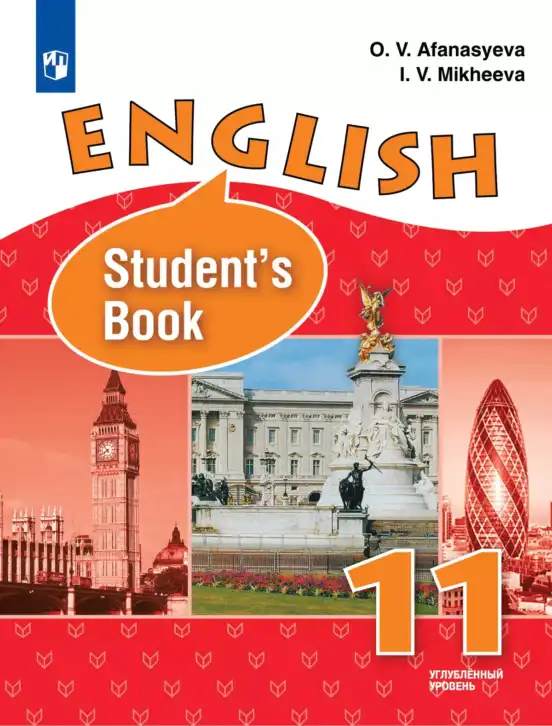
Авторы: Афанасьева О. В., Михеева И. В.
Тип: Student's book (Учебник)
Издательство: Просвещение
Год издания: 2014 - 2025
Уровень обучения: углублённый
Цвет обложки: белый, красный
ISBN: 978-5-09-034233-9
Популярные ГДЗ в 11 классе
Unit Two. Town and Its Architecture. Reading - номер 12, страница 71.
№12 (с. 71)
Условие. №12 (с. 71)
скриншот условия
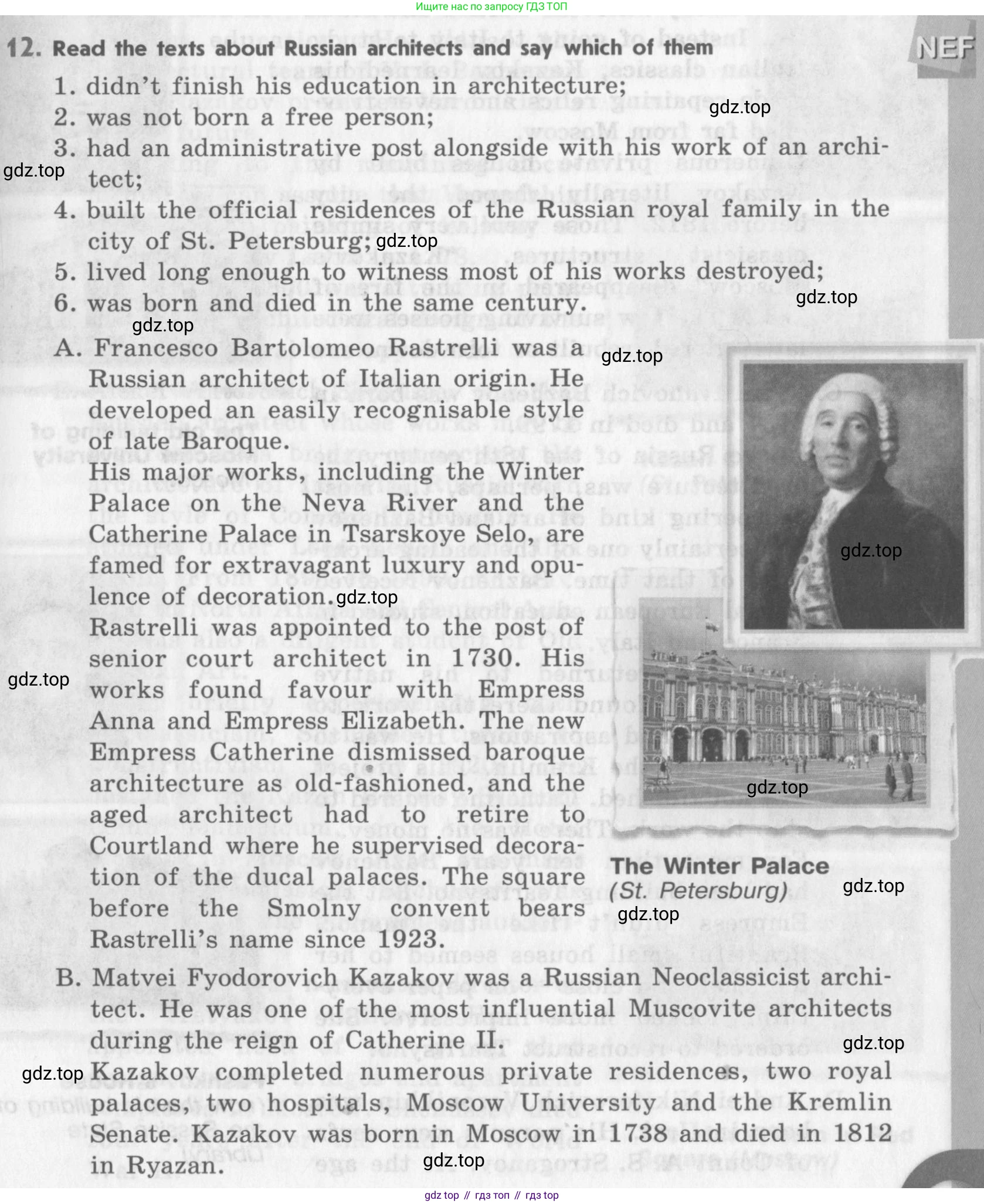
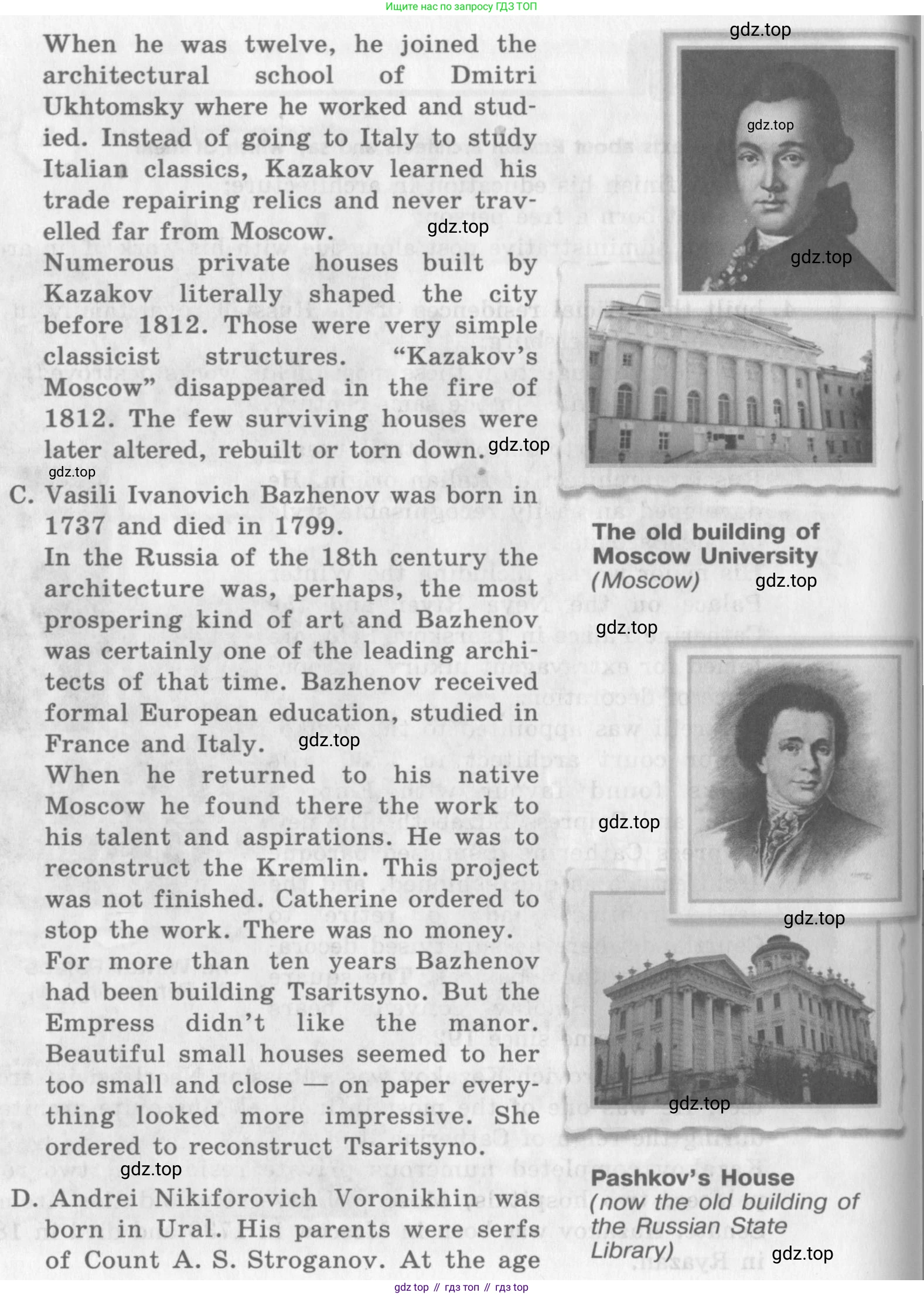
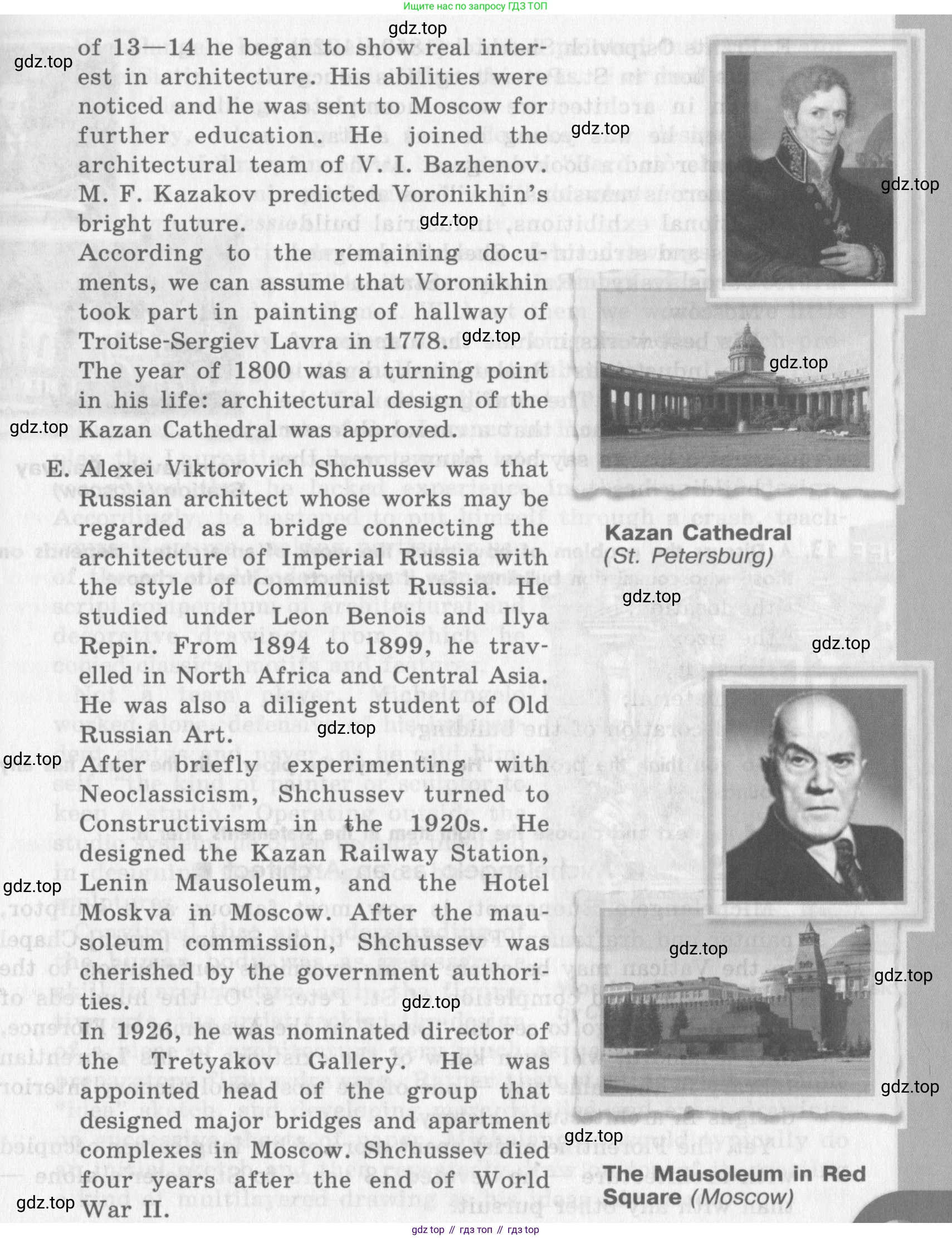
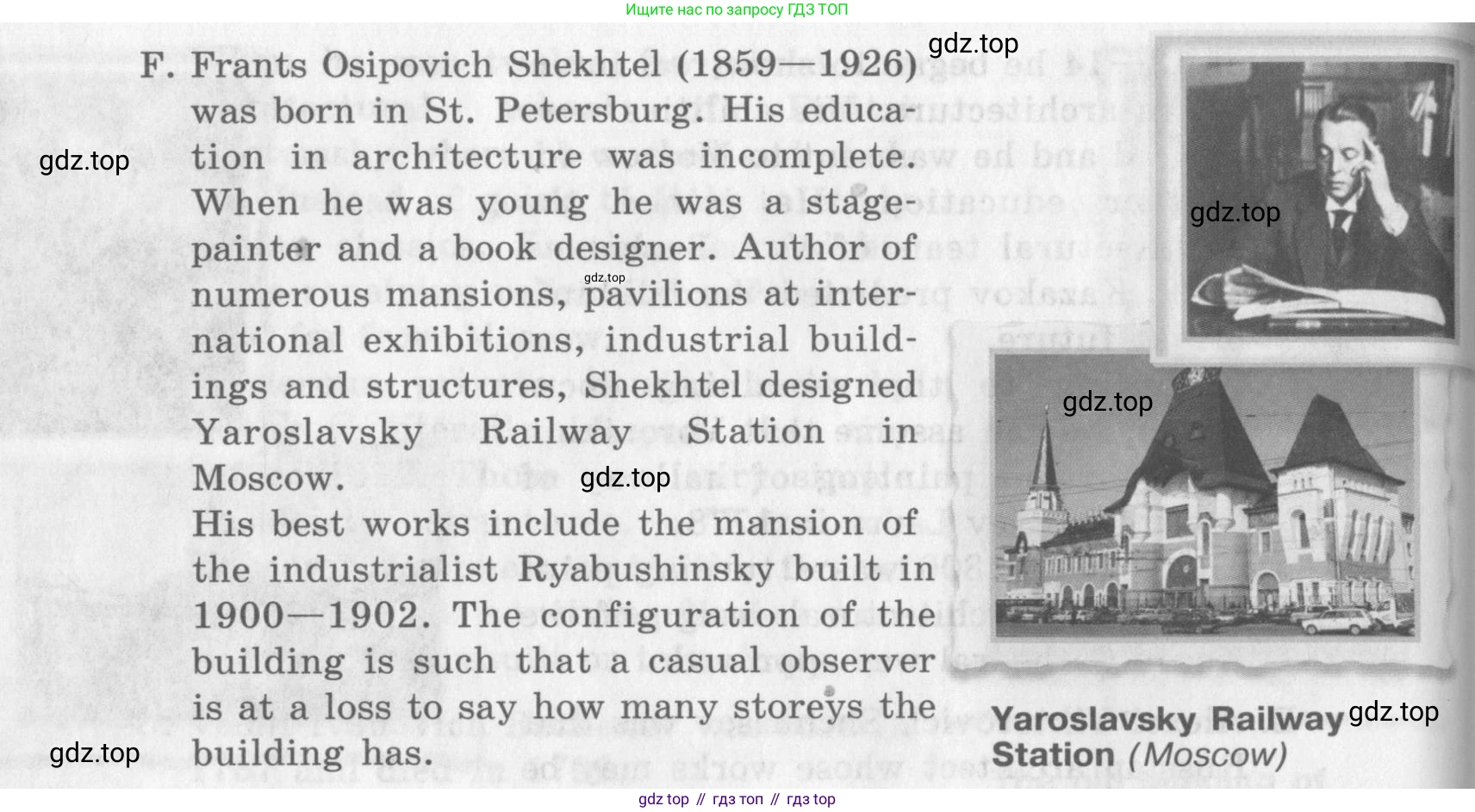
12. Read the texts about Russian architects and say which of them
1. didn’t finish his education in architecture;
2. was not born a free person;
3. had an administrative post alongside with his work of an architect;
4. built the official residences of the Russian royal family in the city of St. Petersburg;
5. lived long enough to witness most of his works destroyed;
6. was born and died in the same century.
A. Francesco Bartolomeo Rastrelli was a Russian architect of Italian origin. He developed an easily recognisable style of late Baroque.
His major works, including the Winter Palace on the Neva River and the Catherine Palace in Tsarskoye Selo, are famed for extravagant luxury and opulence of decoration.
Rastrelli was appointed to the post of senior court architect in 1730. His works found favour with Empress Anna and Empress Elizabeth. But Empress Catherine dismissed baroque architecture as old-fashioned, and an aged architect had to retire to Courtland where he supervised decoration of the ducal palaces. The square before the Smolny convent bears Rastrelli’s name since 1923.
The Winter Palace (St. Petersburg)
B. Matvei Fyodorovich Kazakov was a Russian Neoclassicist architect. He was one of the most influential Muscovite architects during the reign of Catherine II. Kazakov completed numerous private residences, two royal palaces, two hospitals, Moscow University and the Kremlin Senate. Kazakov was born in Moscow in 1738 and died in 1812 in Ryazan.
When he was twelve, he joined the architectural school of Dmitri Ukhtomsky where he worked and studied. Instead of going to Italy to study Italian classics, Kazakov learned his trade repairing relics and never travelled far from Moscow.
Numerous private houses built by Kazakov literally shaped the city before 1812. Those were very simple classicist structures. "Kazakov's Moscow" disappeared in the fire of 1812. The few surviving houses were later altered, rebuilt or torn down.
The old building of Moscow University (Moscow)
C. Vasili Ivanovich Bazhenov was born in 1737 and died in 1799.
In the Russia of the 18th century where architecture was, perhaps, the most prospering kind of art and Bazhenov was certainly one of the leading architects of that time. Bazhenov received formal European education, studied in France and Italy.
When he returned to his native Moscow he found there the work to his talent and aspirations. He was to reconstruct the Kremlin. This project was not finished. Catherine ordered to stop the work. There was no money.
For more than ten years Bazhenov had been building Tsaritsyno. But the Empress didn’t like the manor. Beautiful small houses seemed to her too small and close — on paper everything looked more impressive. She ordered to reconstruct Tsaritsyno.
Pashkov's House (now the old building of the Russian State Library)
D. Andrei Nikiforovich Voronikhin was born in Ural. His parents were serfs of Count A. S. Stroganov. At the age of 13–14 he began to show real interest in architecture. His abilities were noticed and he was sent to Moscow for further education. He joined the architectural team of V. I. Bazhenov. M. F. Kazakov predicted Voronikhin's bright future.
According to the remaining documents, we can assume that Voronikhin took part in painting of hallway of Troitse-Sergiev Lavra in 1778.
The year of 1800 was a turning point in his life: architectural design of the Kazan Cathedral was approved.
Kazan Cathedral (St. Petersburg)
E. Alexei Viktorovich Shchusev was a Russian architect whose works may be regarded as a bridge connecting the architecture of Imperial Russia with the style of Communist Russia. He studied under Leon Benois and Ilya Repin. From 1894 to 1899, he travelled in North Africa and Central Asia. He was also a diligent student of Old Russian Art.
After briefly experimenting with Neoclassicism, Shchusev turned to Constructivism in the 1920s. He designed the Kazan Railway Station, Hotel Moskva in Moscow, and the Lenin Mausoleum in Red Square, Moskva in Moscow. After the mausoleum commission, Shchusev was cherished by the government authorities.
In 1926, he was nominated director of the Tretyakov Gallery. He also appointed head of the group that designed major bridges and apartment complexes in Moscow. Shchusev died four years after the end of World War II.
The Mausoleum in Red Square (Moscow)
F. Frants Osipovich Shekhtel (1859–1926) was born in St. Petersburg. His education in architecture was incomplete.
When he was young he was a stage-painter and a book designer. Author of numerous mansions, pavilions at international exhibitions, industrial buildings and structures, Shekhtel also designed Yaroslavsky Railway Station in Moscow.
His best works include the mansion of the industrialist Ryabushinsky built in 1900–1902. The configuration of the building is such that a casual observer is at a loss to say how many storeys the building has.
Yaroslavsky Railway Station (Moscow)
Решение. №12 (с. 71)

Решение 2. №12 (с. 71)
12. Прочитайте тексты о русских архитекторах и скажите, кто из них:
1. не закончил свое архитектурное образование;
2. не был рожден свободным человеком;
3. занимал административную должность наряду со своей работой архитектора;
4. построил официальные резиденции русской царской семьи в городе Санкт-Петербурге;
5. дожил до того, чтобы увидеть большинство своих работ разрушенными;
6. родился и умер в одном и том же веке.
Ответ:
1. F. Frants Osipovich Shekhtel (Ф. О. Шехтель)
2. D. Andrei Nikiforovich Voronikhin (А. Н. Воронихин)
3. E. Alexei Viktorovich Shchusev (А. В. Щусев)
4. A. Francesco Bartolomeo Rastrelli (Ф. Б. Растрелли)
5. B. Matvei Fyodorovich Kazakov (М. Ф. Казаков)
6. C. Vasili Ivanovich Bazhenov (В. И. Баженов)
Другие задания:
Помогло решение? Оставьте отзыв в комментариях ниже.
Присоединяйтесь к Телеграм-группе @top_gdz
ПрисоединитьсяМы подготовили для вас ответ c подробным объяснением домашего задания по английскому языку за 11 класс, для упражнения номер 12 расположенного на странице 71 к Учебник (Student's book) 2014 года издания для учащихся школ и гимназий.
Теперь на нашем сайте ГДЗ.ТОП вы всегда легко и бесплатно найдёте условие с правильным ответом на вопрос «Как решить ДЗ» и «Как сделать» задание по английскому языку к упражнению №12 (с. 71), авторов: Афанасьева (Ольга Васильевна), Михеева (Ирина Владимировна), ФГОС (старый) углублённый уровень обучения учебного пособия издательства Просвещение.

















